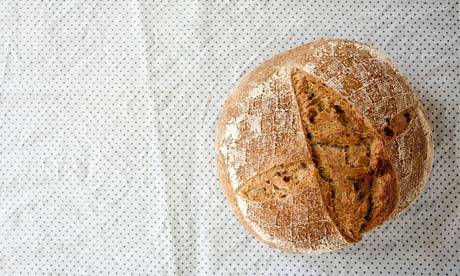
Our growing taste for sourdough is easy to understand. The opposition is rubbish: standard, fast-tracked British bread is a travesty of the baker's art. But a crusty loaf, patiently made in the time-honoured way, using a sourdough leaven harnessing the raising power of wild yeasts, is an object of craft and beauty. Thanks to the lactic and acetic acids that ferment the dough and provide its characteristic tang, the flavour is vastly superior.
While a battery of additives and "processing aids" ensure that our factory-baked breads stay pappy and humid for days before suddenly turning mouldy, this most traditional sort of loaf keeps well, ages gracefully, and need never be wasted. No wonder distinguished sourdough leavens, such as that used in the celebrated pain Poilâne, are treasured and handed down through generations of bakers.
Why is sourdough bread good for me?
Sourdough is more digestible than standard loaves and more nutritious too. Lactic acids make the vitamins and minerals in the flour more available to the body by helping neutralise the phytates in flour that would interfere with their absorption. The acids slow down the rate at which glucose is released into the blood-stream and lower the bread's glycaemic index (GI), so it doesn't cause undesirable spikes in insulin. They also render the gluten in flour more digestible and less likely to cause food intolerance.
Where to buy and what to pay?
Artisan bakeries are sprouting up all over, either selling from their own shops, or through farmers' markets and delis. The loaves are never cheap, reflecting the skill and time that goes into them: £3 is typical for a smallish loaf, but many now also sell quarters.
Joanna Blythman is the author of What To Eat (Fourth Estate, £9.99). To order a copy for £7.99 with free UK p&p, go to guardianbookshop.co.uk
Sourdough bread salad
I am a fan of using bread in an unusual form – it's a great way to use up odds and ends. Here, bread becomes a salad in the style of a Tuscan panzanella.
Serves 4
400g sourdough bread, preferably a bit aged: if not, dry in a low oven for a while
1 garlic clove
1 medium red onion, thinly sliced
1½ tbsp red wine vinegar
4 tbsp olive oil
1½ tbsp capers
2 tbsp green olives stuffed with anchovies, roughly chopped
400g ripe tomatoes, peeled
A few sprigs of oregano, leaves removed from stalks, roughly chopped
Salt and black pepper
1 Cut the garlic clove in half and slice the bread into thick pieces. Rub each piece of bread on both sides with the garlic clove. Rip the bread into bite‑size pieces.
2 Mix the onion with the red wine vinegar, olive oil, capers, olives and tomatoes and season to taste. Throw in the bread pieces and the oregano and mix well. Leave to stand for 30‑60 minutes at room temperature.
3 Taste again and season if necessary.
Serve with a green salad and some cold meat or a good cheese.
Rosie Sykes is head chef of Fitzbillies (fitzbillies.com) and co-author of The Kitchen Revolution (Ebury Press, £25). To order a copy for £19.99 with free UK p&p, go to guardianbookshop.co.uk

